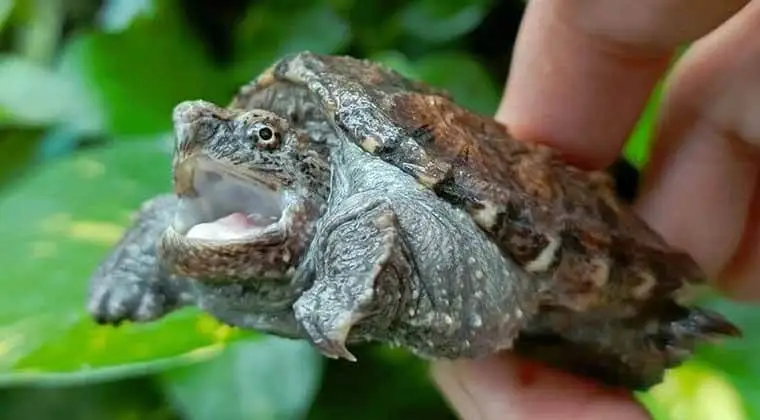Yes, baby snapping turtles are able to swim. In fact, they must swim in order to survive. Baby snappers have flat webbed feet that help them move through the water quickly and efficiently. They use their powerful tails as a rudder for steering, allowing them to navigate quickly around obstacles like rocks or logs.
When swimming, baby snapping turtles will hold their heads close to the surface of the water so they can take in oxygen from both air and water while keeping an eye out for predators. Even though baby snappers spend much of their time underwater, they still need access to land so they can bask in the sun and dry off completely between dives.
Can Baby Snapping Turtles Survive on Their Own?
Baby snapping turtles are incredibly resilient creatures and can often survive on their own in the wild. Although they may be small, they possess strong defenses to help protect themselves from predators such as their hard shells and sharp beaks. They also have the ability to find food sources even in adverse conditions and will travel long distances if necessary.
While it is still important to give baby snapping turtles the best chance at survival by providing them with a safe habitat, they are capable of living independently if released into nature.
Do Baby Snapping Turtles Live in Water?
Yes, baby snapping turtles live in water their entire lives. They are aquatic animals that typically inhabit wetlands and shallow rivers with slow currents or ponds. The first few months of a baby turtle’s life will be spent in the water as they feed on tiny fish, crustaceans, and insect larvae to grow strong and healthy.
As the turtle grows, it will move into deeper waters where there is more food available to sustain larger sizes. Adult snapping turtles can survive both in freshwater habitats such as lakes or streams as well as brackish estuaries where saltwater meets freshwater.
Snapping turtles have also been known to travel far distances over land if necessary for better feeding grounds or breeding opportunities. However, this activity is usually kept at minimal levels due to their vulnerability against predators like large birds of prey when out of the water!
How Long Can Baby Snapping Turtles Be Underwater?
Baby snapping turtles are highly aquatic animals that can stay underwater for long periods of time. They have an incredible ability to hold their breath and remain submerged, which is why they are often seen basking in shallow waters or swimming around riverbeds. On average, baby snapping turtles can stay underwater for up to three hours before needing a break.
This impressive feat is made possible by the turtle’s unique physiology; its lungs allow it to absorb oxygen from the water while its strong leg muscles enable it to move swiftly through the currents. As such, these creatures don’t need frequent resurfacing as other aquatic species do.
Additionally, baby snapping turtles also possess a special adaptation called “cloacal respiration” which allows them to draw oxygen directly from their cloaca without having to surface at all! With this skill, young snappers can remain underwater for even longer amounts of time up to eight hours in total if needed!
Can Baby Snapping Turtles Breathe Underwater?
Yes, baby snapping turtles are capable of breathing underwater. This is because they possess gill-like structures called pseudobranchs located behind the eyes and on either side of their heads, which allow them to extract oxygen from the water and absorb it into their bloodstream. These specialized organs are used in conjunction with normal lungs to provide a steady supply of oxygen while submerged.
Additionally, baby snappers have an ability known as “shallow diving” where they can remain underwater for extended periods without taking in too much air at once or risking drowning. This allows them to scavenge for food or hide from predators if necessary without having to come up for air frequently as other aquatic animals do. So not only can baby snapping turtles breathe underwater; it actually helps improve their chances of survival!
Where Do Baby Snapping Turtles Go?
Baby snapping turtles can be incredibly difficult to find, as they typically stay hidden in the mud and vegetation of shallow ponds. After hatching from their eggs, baby snapping turtles will often remain near the nest site for a few days before dispersing into more permanent wetlands. The majority of newborns will travel to nearby vernal pools or shallow marshes where there is plenty of food and shelter.
These bodies of water are usually full of aquatic plants like cattails, bulrush, and sedges which provide the perfect environment for growing young snappers. As they get bigger and stronger, these young turtles will eventually move on to larger rivers and lakes with deeper waters so they can continue hunting prey items such as frogs, insects, worms, fish, and other small animals that live in freshwater habitats.
Baby Snapping Turtle vs Crayfish
Conclusion
Baby snapping turtles are capable of swimming soon after hatching from their eggs. Their activity levels and size will vary depending on the environment they hatch in, but overall they can swim with ease despite having a large shell.
This is an important adaptation for these turtles as it allows them to access food sources that would otherwise be inaccessible to land-dwelling animals. This knowledge can help us understand how baby snapping turtles survive and thrive in nature.
